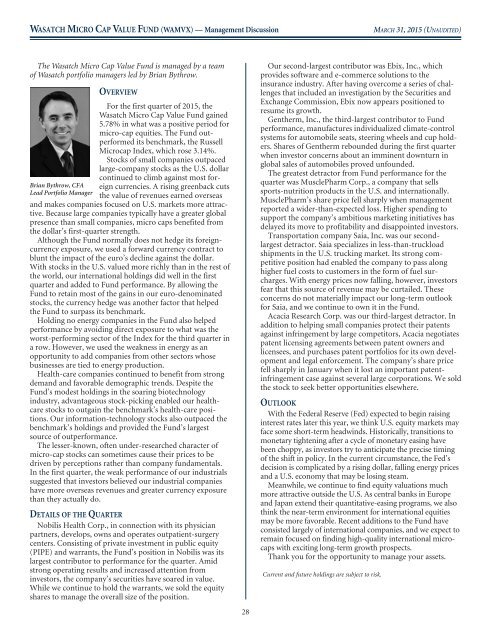WASATCH FUNDS - Curian Clearing
WASATCH FUNDS - Curian Clearing
WASATCH FUNDS - Curian Clearing
You also want an ePaper? Increase the reach of your titles
YUMPU automatically turns print PDFs into web optimized ePapers that Google loves.
<strong>WASATCH</strong> MICRO CAP VALUE FUND (WAMVX) — Management Discussion<br />
MARCH 31, 2015 (UNAUDITED)<br />
The Wasatch Micro Cap Value Fund is managed by a team<br />
of Wasatch portfolio managers led by Brian Bythrow.<br />
Brian Bythrow, CFA<br />
Lead Portfolio Manager<br />
OVERVIEW<br />
For the first quarter of 2015, the<br />
Wasatch Micro Cap Value Fund gained<br />
5.78% in what was a positive period for<br />
micro-cap equities. The Fund outperformed<br />
its benchmark, the Russell<br />
Microcap Index, which rose 3.14%.<br />
Stocks of small companies outpaced<br />
large-company stocks as the U.S. dollar<br />
continued to climb against most foreign<br />
currencies. A rising greenback cuts<br />
the value of revenues earned overseas<br />
and makes companies focused on U.S. markets more attractive.<br />
Because large companies typically have a greater global<br />
presence than small companies, micro caps benefited from<br />
the dollar’s first-quarter strength.<br />
Although the Fund normally does not hedge its foreigncurrency<br />
exposure, we used a forward currency contract to<br />
blunt the impact of the euro’s decline against the dollar.<br />
With stocks in the U.S. valued more richly than in the rest of<br />
the world, our international holdings did well in the first<br />
quarter and added to Fund performance. By allowing the<br />
Fund to retain most of the gains in our euro-denominated<br />
stocks, the currency hedge was another factor that helped<br />
the Fund to surpass its benchmark.<br />
Holding no energy companies in the Fund also helped<br />
performance by avoiding direct exposure to what was the<br />
worst-performing sector of the Index for the third quarter in<br />
a row. However, we used the weakness in energy as an<br />
opportunity to add companies from other sectors whose<br />
businesses are tied to energy production.<br />
Health-care companies continued to benefit from strong<br />
demand and favorable demographic trends. Despite the<br />
Fund’s modest holdings in the soaring biotechnology<br />
industry, advantageous stock-picking enabled our healthcare<br />
stocks to outgain the benchmark’s health-care positions.<br />
Our information-technology stocks also outpaced the<br />
benchmark’s holdings and provided the Fund’s largest<br />
source of outperformance.<br />
The lesser-known, often under-researched character of<br />
micro-cap stocks can sometimes cause their prices to be<br />
driven by perceptions rather than company fundamentals.<br />
In the first quarter, the weak performance of our industrials<br />
suggested that investors believed our industrial companies<br />
have more overseas revenues and greater currency exposure<br />
than they actually do.<br />
DETAILS OF THE QUARTER<br />
Nobilis Health Corp., in connection with its physician<br />
partners, develops, owns and operates outpatient-surgery<br />
centers. Consisting of private investment in public equity<br />
(PIPE) and warrants, the Fund’s position in Nobilis was its<br />
largest contributor to performance for the quarter. Amid<br />
strong operating results and increased attention from<br />
investors, the company’s securities have soared in value.<br />
While we continue to hold the warrants, we sold the equity<br />
shares to manage the overall size of the position.<br />
28<br />
Our second-largest contributor was Ebix, Inc., which<br />
provides software and e-commerce solutions to the<br />
insurance industry. After having overcome a series of challenges<br />
that included an investigation by the Securities and<br />
Exchange Commission, Ebix now appears positioned to<br />
resume its growth.<br />
Gentherm, Inc., the third-largest contributor to Fund<br />
performance, manufactures individualized climate-control<br />
systems for automobile seats, steering wheels and cup holders.<br />
Shares of Gentherm rebounded during the first quarter<br />
when investor concerns about an imminent downturn in<br />
global sales of automobiles proved unfounded.<br />
The greatest detractor from Fund performance for the<br />
quarter was MusclePharm Corp., a company that sells<br />
sports-nutrition products in the U.S. and internationally.<br />
MusclePharm’s share price fell sharply when management<br />
reported a wider-than-expected loss. Higher spending to<br />
support the company’s ambitious marketing initiatives has<br />
delayed its move to profitability and disappointed investors.<br />
Transportation company Saia, Inc. was our secondlargest<br />
detractor. Saia specializes in less-than-truckload<br />
shipments in the U.S. trucking market. Its strong competitive<br />
position had enabled the company to pass along<br />
higher fuel costs to customers in the form of fuel surcharges.<br />
With energy prices now falling, however, investors<br />
fear that this source of revenue may be curtailed. These<br />
concerns do not materially impact our long-term outlook<br />
for Saia, and we continue to own it in the Fund.<br />
Acacia Research Corp. was our third-largest detractor. In<br />
addition to helping small companies protect their patents<br />
against infringement by large competitors, Acacia negotiates<br />
patent licensing agreements between patent owners and<br />
licensees, and purchases patent portfolios for its own development<br />
and legal enforcement. The company’s share price<br />
fell sharply in January when it lost an important patentinfringement<br />
case against several large corporations. We sold<br />
the stock to seek better opportunities elsewhere.<br />
OUTLOOK<br />
With the Federal Reserve (Fed) expected to begin raising<br />
interest rates later this year, we think U.S. equity markets may<br />
face some short-term headwinds. Historically, transitions to<br />
monetary tightening after a cycle of monetary easing have<br />
been choppy, as investors try to anticipate the precise timing<br />
of the shift in policy. In the current circumstance, the Fed’s<br />
decision is complicated by a rising dollar, falling energy prices<br />
and a U.S. economy that may be losing steam.<br />
Meanwhile, we continue to find equity valuations much<br />
more attractive outside the U.S. As central banks in Europe<br />
and Japan extend their quantitative-easing programs, we also<br />
think the near-term environment for international equities<br />
may be more favorable. Recent additions to the Fund have<br />
consisted largely of international companies, and we expect to<br />
remain focused on finding high-quality international microcaps<br />
with exciting long-term growth prospects.<br />
Thank you for the opportunity to manage your assets.<br />
Current and future holdings are subject to risk.




